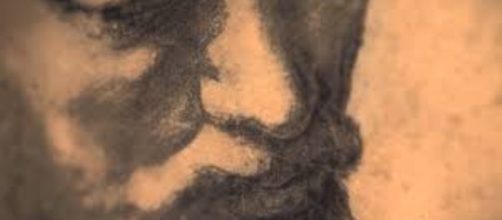When it comes to the Old Masters, the big three were Leonardo, Michelangelo and Raphael, each true to the Renaissance ideals of naturalism and emotional expression. But they had different strength. Raphael’s was a knacks for conveying subtle states of mind like patience and peacefulness – and that strength is in the news at the moment in a chalk drawing called “Head of a Young Apostle” that sold for a record-breaking $47.8 million at Sotheby’s in London. The sketch was made in preparation for the artist’s last painting titled “Transfiguration” and details the head of one of the 11 apostles in the finished work in identical size and state of finish.
A claim to fame
You can spot this particular apostle in the painting in the shadows on the far left side, And if you compare the drawing to the painted version, the first thing that will likely occur to you is that for a sketch, Raphael went to a lot of trouble to exact the man’s expression and extent. Lights and shadows are drawn just as they are painted, which lend the chalk work a solid, sculptural feel. How remarkable is this? You don’t ever hear the following statement from an auction house intent on selling many drawings: “This is the most intensely moving and powerful drawing we’ve ever had.” So says Gregory Rubenstein, Sotheby’s senior director of Old Master drawings, in a company video.
One of a kind
As already mentioned, the feelings that Raphael sought to impart are not the stuff of paintings like “The Scream” by Munch. He was bent on showing serenity. A useful example is “The Madonna of the Chair,” which he painted on a circular canvas to accentuate repose. It goes without saying that while peace and harmony was his thing, this wasn’t characteristic of the creative world. Giorgio Vasari, the historian living in the artist’s time, practically swooned over his distinctiveness saying that until he came along, artists showed “outlandish and eccentric” behavior and concluded, “One can claim without fear of contradiction that an artists as outstanding as Raphael are not simply men, but mortal gods.”
There's no comparison
Of course, Vasari wasn't only talking of Raphael’s temperament.
The man could paint as smooth as silk feels. But here’s the thing. As gifted and accomplished as he was, he worried as if he were a beginner just getting the hang of painting. In one instance, he stewed over a commission from the Vatican fretting that he didn’t think he could fulfill his idea of beauty.
He vented his anxiety to a friend in the Italian court - Count Baldassare Castiglione, saying, ”Unless everybody is flattering me, I have satisfied everybody; but I do not satisfy my own judgment.” Perhaps if he lived today when a court ruled against the ballyhooed artist of our time, Jeff Koons, for plagiarizing an image for one of his sculptures featured at the Pompidou Centre, his self-image would improve.

